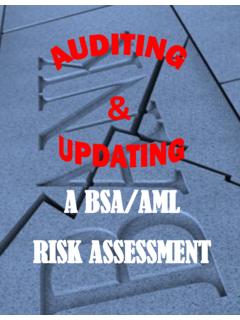Transcription of AML Rule Tuning: Applying Statistical and Risk …
1 aml rule tuning : Applying Statistical and Risk-Based Approach to Achieve Higher Alert Efficiency By: Umberto Lucchetti Junior, CAMS-FCI 2 Table of Contents 1. Executive Summary .. 3 2. Introduction .. 4 3. Applying a Risk-Based Approach to the P Transaction MonitoringScenerios . 5 a. Implementation of a Population Group to the Transaction Monitoring Scenarios .. 7 b. Implementation of a Suppression Logic to the Transaction Monitoring Process .. 9 4. Qualitative and Quantitative tuning of the Transaction monitoring scenarios .. 10 a. Gap analysis.
2 10 b. Statistical tuning of the Transaction Monitoring Scenerios .. 12 5. Conclusion .. 15 3 1. Executive Summary Recent fines against banks, such as, the ones applied to Standard Chartered Bank,1 Saddle River Valley Bank2 and HSBC Bank,3 for failing to detect suspicious activity and therefore failing to comply with the transaction monitoring portion of the compliance program, have demonstrated the importance of having a sound anti-money laundering (AML) compliance program. In order to maintain AML detection scenarios current with best market practices, rule tuning exercises have become an ever-increasing important task to perform at a financial institution.
3 The methodologies to tune AML detections scenarios are also becoming more complex with heightened expectations from regulators. The tuning needs to be constant, that is, continuously applied over time to identify potential new risks or new typologies not covered by the current process in place. Likewise the application of a risk-based approach to the transaction monitoring process should also be taken into consideration by banks since it helps to focus the efforts and resources of staff on what poses a higher money laundering risk for the institution.
4 This tuning will directly benefit the financial intelligence unit (FIU) and consequently the financial crime investigators who will have more productive alerts to review, having more time to investigate the potential suspicious alerts, therefore, improving the transaction monitoring process as a whole. Based on that, this white paper provides an overview of the importance of the aml rule tuning and the application of the risk-based approach to the transaction monitoring process, defining and giving examples on how to implement and perform these two important processes to the transaction monitoring scenarios of a bank.
5 1 From the New York State Department of Financial Services Press Release of August 19, 2014. 2 From FinCEN Assessment of Civil Money Penalty of September 24, 2013. 3 From FinCEN Assessment of Civil Money Penalty of December 10, 2012. 4 2. Introduction The identification and reporting of suspicious activity is one of the most important processes of an institution s compliance program. Within the suspicious activity reporting, the transaction monitoring process plays an important role on the identification of unusual activity.
6 According to the Federal Financial Institutions Examination Council (FFIEC) manual,4 the sophistication of monitoring systems should be dictated by the bank s risk profile, with particular emphasis on the composition of higher-risk products, services, customers, entities, and jurisdictions. 5 The basis for the development of the monitoring systems should be on the Bank Secrecy Act/anti-money laundering (BSA/AML) risk assessment, which is a mandatory assessment to be conducted by banks as part of the compliance program. This assessment highlights areas of a bank s risk, and exposes any potential gaps in controls that should be implemented to mitigate these risks .
7 Most of the banks rely on automated systems to identify unusual activity and generate alerts. Using the same concept, the sophistication and complexity of this system should be based on the bank s risk profile. Banks are subject to findings by examiners on the suspicious activity reporting portion of the compliance program because the AML system is not properly tuned in accordance with the bank s risk profile. Outdated rules oftentimes cause an inefficient allocation of resources as analysts have a high number of false positive alerts to review.
8 A high number of false positive alerts present a bank s AML program with a risk where the analysts may not have the sufficient time to handle all alerts with a high quality review, where potentially suspicious activity may be overlooked. 4 The Federal Financial Institutions Examination Council (FFIEC) Bank Secrecy Act (BSA)/Anti-Money Laundering (AML) Examination Manual provides guidance to examiners for carrying out BSA/AML and Office of Foreign Assets Control (OFAC) examinations. An effective BSA/AML Compliance Program requires sound risk management; therefore, the manual also provides guidance on identifying and controlling risks associated with money laundering and terrorist financing.
9 The manual contains an overview of BSA/AML Compliance Program requirements, BSA/AML risks and risk management expectations, industry sound practices, and examination procedures. 5 From the FFIEC Manual, Suspicious Activity Reporting Section: ( ) 5 As per IPSA International6 one of the biggest issues facing investigators is the generation of a 'false positive.' A false positive is not an accurate alert and should not be flagged for investigation. This results in a lower productivity for the investigator and increases the likelihood of a true positive being spotted.
10 7 One of the potential solutions for this lack of proper tuning of the transaction monitoring process is the application of a risk-based approach and the qualitative and quantitative tuning of the transaction monitoring scenarios in order to achieve a higher alert efficiency, therefore, improving the suspicious activity reporting process as a whole. 3. Applying a Risk-Based Approach to the P Transaction MonitoringScenerios According to the Wolfsberg Group8 guidance, financial institutions should design and implement appropriate measures and controls to mitigate potential money laundering risks of those customers that are determined to be higher risk as the result of the institution s risk assessment process.









